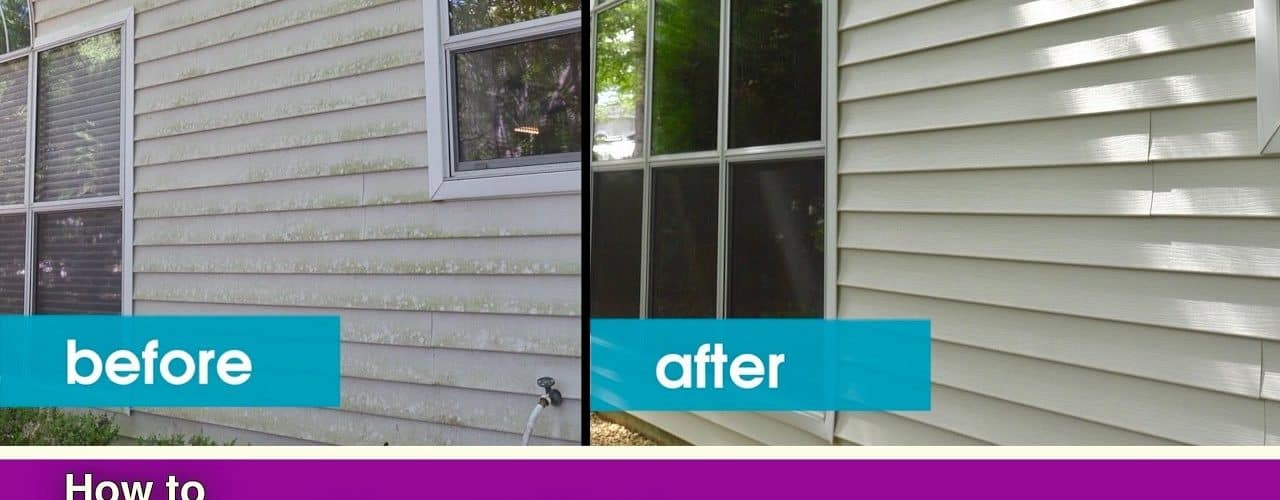It’s dingy and dusty, dirty and damp, dark and discolored, dank and distressed. It’s unclean vinyl siding. And it’s a clean-up job awaiting you.
Contents
What Is Vinyl?
Vinyl siding is composed of polyvinyl chloride (PVC), a known carcinogen. It emulates natural wood, so as to enhance the aesthetic appeal of a home. Although the traditional vinyl colors – beige and white – still thrive, many homeowners are turning to more unique hues – red, green, yellow, brown – for some panache.
Vinyl siding is the most popular type of siding the U.S., due in a large part to salesmen’s persistent proclamations of durability, versatility, and affordability. It is sold by 100 sq. ft. “squares.”
Is It Time to Clean?
Vinyl faces foes at every turn. Trees and plants release airborne sugars that coat vinyl surfaces and become a prime place for mold and algae. Particulate matter from engines – particularly diesel engines – can smother vinyl siding. High winds, acid rain, dust and bird droppings are also responsible for the steadily accumulating grime.
What to Choose?
Unfortunately, not every homemaker is a born Mary Poppins or June Cleaver. For such souls, some necessary instruction is required.
There are two basic methods for washing vinyl: power washing v. washing by hand.
Power Washer
Pros: For all the mechanically-inclined DIYs and time-constrained laborers, power washing may be the solution to all your dreams and problems. Power washing takes less time than washing by hand, and generally returns better results. It can clean concealed and hard-to-reach areas, and is more suitable for washing high walls and roofs.
Cons: The only definitive con to power washing is its larger environmental footprint. Using a power washer requires gas, oil or electricity, all of which not only cost money to use but are produced using fossil fuels (electricity is generally created by coal). Other potential problems including spraying through open nooks and drenching the interior. Also, as vinyl is designed to protect from rain pouring down, and not water shooting up, water may seep through unnoticed cracks and cause rot, mildew and mold.
Washing by Hand
Pros: Washing by hand has two advantages over power washing. First, it reduces the environmental footprint caused by using a power washer. Second, it is more versatile than power washing and does not require the allocation of big blocks of time for cleaning.
Cons: Time is money, and washing by hand takes lots of time. It can be very labor-intensive and is not feasible for many on-the-go professionals. It also may not return as good of results as power washing.
How to Clean?
Step 1) Protect all open nooks and crannies, including doors, windows and wall seams. Cover all electrical outlets and any etched metal or glass; shelter any plants or vegetation.
Step 2) Concoct a cleaning liquid. (Don’t use chlorine bleach – it kills flora and fauna. If you require a powerful cleaning agent, use eco-friendly oxygen bleach.) A ½ vinegar ½ water mixture works quite well, as does a mixture of laundry detergent and water, or mixture of Windex® or Fantastik®. Adjust the amount of active ingredient depending on the quantity of mildew and dust.
Step 3) Begin washing, using a power washer, a long-handled brush, a hose, or hand-held scrubber. Begin on the side facing the sun.
Step 4) Point the power washer or hose nozzle at a 45-degree angle. Wash the siding from top to bottom, side to side, in 3-5 foot sections. Slightly angle the water stream downwards.
Step 5) Rinse each area with fresh water after cleaning. Let dry in the sun.
Cleaning complete.



